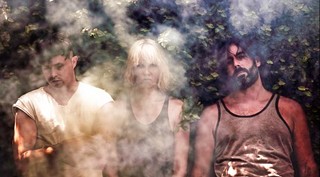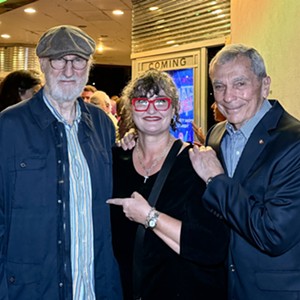1. Goodbye Rochelle. Don't let the door hit you in the...
Yeah, we know you're tired of reading about Rochelle Small-Toney in our annual Year in Review issue. Over the years we've become pretty tired of writing about her ourselves.
But apparently this will be the last time. Or we certainly hope so, anyway.
There can be no doubt whatsoever that one of the top stories in Savannah from 2012 was the epic decline and fall of the controversial and divisive former city manager, who wrote a new chapter in the local book of shame.
Though appearing to have consolidated an absolute stranglehold on local politics (and on the newly inaugurated mayor and council) as recently as spring, by the summer a series of damaging leaks hit the local press, and the previously unsinkable SS Rochelle began taking on water.
The first iceberg she ran into was the reporting of her myriad of travel policy abuses. Most were individually petty and not atypical for pay-to-play corporate execs - a shuttle rented for $150 to travel one city block, an extra day at a convention to play golf - but for a city manager of a lightly populated burg in the deep South whose salary depended on taxpayer largesse, it seemed extravagant in the extreme.
More disturbing, though, was her cavalier attitude towards documenting those expenses. Small-Toney reserved the right to submit backdated, hand-written "receipts" when she had severely disciplined other city employees for much less egregious accounting oversights.
Immediately after that came proof that a crony she'd hired to run the city emergency management had lied rather egregiously on his resume.
But the real rough seas came when reports came out in late summer that due to Small-Toney's heavy-handed management the city purchasing department was many months in arrears in paying important vendors. With credit effectively exhausted, the city was faced with imminent disappearance of services taxpayers had already funded.
A previously supportive Mayor Edna Jackson - who among many other residents had hailed the appointment of the first African American female city manager - finally had enough. She first assembled enough votes to formally reprimand Small-Toney in August. While the terms of the reprimand indicated a probationary period, experienced tea-leaf readers were able to see that Jackson was setting the stage for an eventual, and inevitable, parting of the ways.
By early October, as the damaging headlines continued and Small-Toney persisted in throwing her subordinates under the bus rather than showing any real accountability or remorse, Jackson was was able to mobilize five votes besides her own on the nine-member council to accept Small-Toney's resignation at long last.
Small-Toney, who apparently resigned purely to receive a contractual golden parachute and whose resignation letter mentioned almost nothing except how much money she thought she was owed, immediately left her home in Southbridge (outside Savannah city limits) for the next bunch of gullible politicians somewhere in this big nation of ours - along with about $60,000 in screw-you money, a reluctant parting gift to her courtesy of long-suffering Savannah taxpayers.
Longtime city employee Stephanie Cutter was named acting city manager within minutes of the vote to fire Small-Toney. In a speech which marked a considerable political maturation and step-up in leadership, Mayor Jackson said in council chambers, "This is a beginning again for all of us... not a black Savannah or a white Savannah, but a united Savannah that must stay together for the good of all people."- Jim Morekis
2. Crime wave shocks, horrifies
The true-crime stories in Savannah in 2012 nearly defied belief: A high school senior, or what was left of her, found in the trunk of a car that had been burned to a crisp. Two people shot and killed by a sniper while driving by in their car. Seven people shot at a crowded fairground. A man shot and killed on crowded River Street. A man with a long criminal history shooting and killing two people and injuring a third. Shots fired at a football game in Daffin Park on a Saturday morning.
And those were just the most egregious examples. So far in 2012 we've had 24 homicides and many, many non-fatal shootings.
The body count and the luridly graphic circumstances seemed like something out of a war movie instead of life in what is touted as a world-class tourist destination. And at times, Savannah felt like a war zone.
Savannah/Chatham Metro Police, led by Chief Willie Lovett, did make meaningful progress in most of the high-profile cases. A suspect was taken into custody for the murder of high school senior Amber DeLoach, as well as the River Street killing. All the fairground shooting suspects were arrested. Police stepped up patrols at the crowded Daffin Park games.
In a disturbing interview toward year's end - after the terrifying summertime violence spike had mostly subsided - Chief Lovett said that organized gangs appeared to be making a reappearance on Savannah streets after a long absence. Mayor Edna Jackson addressed the city's parents, insisting that the days of letting parents off the hook for their children's crimes were over.
But despite the best efforts of law enforcement, as the nation reels from the catastrophic school shooting in Newtown, CT - which resulted in a similar death toll as Savannah's within the space of a few minutes - Savannah remains in the thrall of gun-toting miscreants from the Islands to the Westside, with few real answers in sight. - Jim Morekis
3. River rage
The fight continued throughout 2012 to protect the Ogeechee River from toxic dumping by King America Finishing. After 40,000 dead fish were found floating downstream the chemical manufacturing plant in May 2011, residents near and far have been called to action with protests and petitions.
The Ogeechee Riverkeeper (ORK) has held fast to its mission of protecting the river, launching a public awareness campaign and attempting legal recourse in a multitude of ways.
When the state's Environmental Protection Department determined that KAF had been spewing effluent from its fire retardant line illegally for five years, it issued a $1 million fine - even though the EPD could have (and most say should have) fined the company the maximum punishment of $50,000 a day, which would have come to $90 million. To add insult to injury, the EPD granted KAF a legal permit to discharge its wastewaster in July - even after more dead fish appeared in May. ORK filed a lawsuit to contest the legality of that permit (as well as another suit that holds KAF accountable for its mess under the federal Clean Water Act.) The permit was withdrawn by the EPD in October thanks to the pressure placed by ORK.
A Bulloch County judge invalidated the first pathetic EPD order in July, allowing the Riverkeeper to proceed with its lawsuits. A new consent order issued in November wasn't much better and details how the paltry $1 million paid by KAF will be broken down: $75,000 for third-party monitoring of the effluent discharge pipe, $160,000 to improve the decrepit wastewater facilities at the nearby city of Millen, and a little more than $750,000 to build a "nature center to study the ecology of the Ogeechee River" at Georgia Southern University.
No explanation accompanies the EPD memo as to why the bulk of the KAF money won't go to citizens who have lost their livelihoods and seen their property values plummet but to GSU, which already has a world-class wildlife education facility.
The Ogeechee Riverkeeper and its challenges garnered national support this year. Activist Erin Brockovich visited Savannah in late October to lend her support to the cause. Speaking to a crowd of more than 200 at Love's Seafood on the banks of the river, the environmental icon promised to help pay for water testing and to use her significant pull to influence national leaders.
"It's time for the people to direct the regulators... if we keep thinking [the problem] is going away, we are mistaken," said Brockovich, who famously represented a cancer-ridden community in a 1996 lawsuit against Pacific Gas & Electric for poisoning the groundwater in Hinkley, CA.
"What it takes is us as citizens pushing back against the agency ... it's supposed to be there to protect us."
There have also been administrative changes at ORK: After ten years at the helm, Ogeechee Riverkeeper Dianna Wedincamp departed at the end of November to start a consulting firm. Her position has been filled in the interim by Emily Markesteyn, Ogeechee Riverkeeper's Executive Director, and Jessica Mnieckowski, ORK's Outreach Director.
Not surprisingly, the Ogeechee River tops the Georgia Water Coalition's 2012 Dirty Dozen list. It appears as long as KAF is allowed to keep dumping, it'll stay there. - Jessica Leigh Lebos
4. Movies 'r' Us
Who says history never repeats? In 2012, two major movies were made in Savannah ... the first time this has happened since, oh, 2010, when both The Last Song and The Conspirator went before the cameras.
This year it was CBGB, the story of the legendary New York City nightclub (well, it was actually more of a hole in the wall) that gave birth to the Ramones, Blondie, Television, Talking Heads and many others.
Unclaimed Freight Productions was at Meddin Studios in June and July shooting the film, which stars Alan Rickman as CBGB founder Hilly Kristal.
Just wrapped last week, at Savannah Arts Academy, was the dark comedy Killing Winston Jones, with Danny Glover and Richard Dreyfuss.
Along with the location, these films have something else in common: Joel David Moore, who plays singer Joey Ramone in CBGB, is Winston Jones' director.
"I fell in love with this town," Moore says. "When I knew that we had the opportunity to shoot in Georgia, I brought it back to Savannah because of the way that it looked - this beautiful school, and the homes that we were able to shoot in.
"And everything around town. It's one of my favorite little downtowns that I've ever been in."
Moore, who's appeared in Avatar, Dodgeball and numerous TV series, is a native of Portland, Oregon. "They're similar in ways," he explains. "They have a lot of interesting history. And interesting weather!
"I really love Savannah; it's still a city, but it's got that quaint, small feeling to it, so it's not overbearing. We've just had a blast. Everybody from the City, up and down, has helped us. And we got a lot of help from Meddin Studios."
Moore's cast also includes Jon Heder (Napoleon Dynamite), Danny Masterson (That ‘70s Show), Joely Fisher (‘Til Death), Aly Michalka (The Roommate), Lesley-Anne Brandt (Spartacus: Gods of the Arena) and Lin Shaye (There's Something About Mary).
Moore says he received the script for the film - about a battle over naming rights to a middle school gymnasium - in 2010 from his cousin's boyfriend ("They're married now," he explains. "So he's my cousin-in-law").
Georgia, because of the liberal tax incentives it offers to lure filmmakers, is becoming the go-to state on the east coast.
That's what brought the CBGB team here over the summer, with its cast including Rupert Grint, Malin Akerman and Donal Logue.
CBGB producer Brad Rosenberger says the movie is in post-production in Los Angeles at the moment, "working on sound and color. The film is turning out great. We're quite pleased with it." Rosenberger says it should be ready in the spring, once Unclaimed Freight makes a distribution deal.
"Savannah," he adds, "was a blast. The people treated us great. We felt like folks were genuinely excited about our film; everyone I came into contact with was really happy we brought our show to the South! I always got a thumbs-up every time I was in town and was wearing my CBGB T-shirt or laminate. I had quite a few lengthy conversations with folks who just wanted to know about the story, the actors, et cetera."
He adds: "In particular, the baristas at Starbucks on Abercorn and Montgomery were very friendly and very supportive. And the kids from SCAD were awesome ... talented, hard-working and very appreciative of the whole experience."
For Moore, playing the lanky New Yorker Joey Ramone was a kind of payback. "The first shirt that I was allowed to buy by myself, because I was a little skater kid, was a Ramones shirt," he says. "So there's a lot of history for me in there that was really fun.
"My parents didn't let me get anything with bones, skulls, crossbows, anything like that - they didn't want any violence on the shirt. But the Ramones shirt was just the four of them, sitting in leather jackets. So it was perfect. It was exactly what I needed." - Bill DeYoung
5. Obama in, Chisolm Out
November's election brought a couple of important developments. The most obvious of them was the reelection victory of President Barack Obama in Chatham County. In numbers mirroring the 2008 total, Obama received 55 percent in contrast to Mitt Romney's 43 percent.
The results were only a surprise largely to the Republican tea party hardcore, however. Most truly objective prognosticators around the country saw the same or higher minority turnout across the nation in favor of Obama, with Chatham County being no exception.
Longtime Washington "outsider" Jack Kingston - actually a veteran congressman first elected the same year Bill Clinton became president - scored another reelection victory, though at 53 percent was a bit less impressive than his usual romp. This time Jack's victory came with the added twist of once again being Savannah's sole representative, due to the umpteenth redistricting effort by Republicans against Democrat John Barrow.
And once again, Barrow was reelected despite yet another Republican assault, this time from the comically sinister-looking Lee Anderson - though not before a ridiculously over-the-top ad featuring Barrow cocking and caressing a rifle made him a laughingstock all over the internet and social media.
Far more surprising - and with potentially much greater local impact - was the defeat of incumbent Chatham County District Attorney Larry Chisolm by Republican Meg Daly Heap, herself a former county prosecutor.
Relying on a savvy campaign of reaching out to likely Obama voters as well as consolidating Republican support, Heap was able to convincingly defeat Chisolm, who despite a series of well-publicized departmental scandals still had the power of incumbency on his side, as well as President Obama's considerable local coattails among African American voters.
In the end, public disgust over Chisolm's mishandling of the death penalty case against Ashleigh Moore's accused killer, various lawsuits against Chisolm himself, and a frightening increase in local violent crime pushed more than enough voters to Heap's side. She enters office with a clear mandate from the citizens as well as a frustrated Police Chief Willie Lovett to take action to stop the revolving door in the local justice system which permits so many recidivist offenders back on the streets. - Jim Morekis
6. Otis Brock III: RIP
Savannah's educational and political community was rocked by the April death of Otis Brock III, operations chief for the Savannah/Chatham public schools. The 41-year-old left behind a wife and two young daughters. He died of a heart attack while in his office at school headquarters at 208 Bull St.
Frequently mentioned as a possible future school superintendent or even Savannah mayor, the enormously well-regarded and respected Brock was one of a handful of local citizens able to easily cross the often-frustrating racial divide in Savannah politics.
One could also make the case, if one is being entirely honest, that he was also a prime mover in the current local paradigm whereby sales tax dollars and the facilities they build are the drivers of school system decisions rather than purely educational reasons. In any case, Brock's shoes are certainly big ones to fill and it will be interesting to see how the school board and system continue to adapt to his loss. - Jim Morekis
7. Busy businesses
In spite of a national economy that's slugging along, it's been a busy year for homegrown Savannah businesses. Some have moved, some have morphed, and there seems to be plenty of prosperity to go around:
Levy Jewelers brought major sparkle to the corner of Bull and Broughton Streets in November when it moved into the grand Mid-Century Modern edifice that has housed various department stores and restaurants over the decades. Owner Lowell Kronowitz, whose great grandfather Aaron Malitz Levy first operated a downtown watch repair shop in 1900, bought the coveted piece of real estate last year and has transformed its three stories into one of Savannah's most deluxe shopping experiences.
"It's a joy to bring this landmark building back to life and make it a retail anchor once again on Broughton Street," said Kronowitz.
Boasting 5,000 square feet of retail space to showcase beautiful baubles, Rolex watches and exclusive giftware designs, the brightly-lit flagship location is twice the size of its former location down the street that it occupied for 75 years. Cozy seating, a children's play area and a refreshment bar are designed to help customers peruse longer and more happily. On a recent visit, holiday gift shopping season appeared to be in full swing - there will be plenty of delighted smiles in Savannah when some lucky loved ones open those pretty silver boxes.
Further down on Broughton, the new Blick Art Materials is fulfilling the prophecy of former Primary Art Supply co-owner Robyn Reeder. When it was announced this summer that the Blick chain would be buying out the beloved Savannah staple, Reeder promised that instead of the usual tale of a giant corporation sucking the soul out of a local business, the new Blick Superstore would be "like Primary on steroids."
True enough, the airy warehouse at 318 E. Broughton is twice the size as the old Primary building, pumped with 20,000 different kinds of materials and newly-added custom framing and fine art printing services. Sales are up as Primary's core base of SCAD students has been joined with craft enthusiasts and hobbyists shopping for quality supplies.
There are also plenty of familiar details: Blick hired much of Primary's staff to man the registers and has kept Reeder on as a consultant. Savannah artist Panhandle Slim has several of his folk portraits hanging on the east wall, and other local artists have hosted pop-up galleries and art demos in the upstairs workshop space.
This is Blick's 38th retail location, but retaining the independent vibe is part of the corporate vision. Ed Ogorzaly, Blick's retail president, is proud to have added new jobs to Savannah's economy while preserving the community created by Reeder and co-owner Amy Spurlock. In fact, it's their foundation that keeps Blick going strong:
"Robyn Reeder and the Primary staff inspire us," said Ogorzaly in a press release. "Blick is about family, Blick is about community, and - much like Primary - Blick is about supporting the arts and students of the arts."
The cinematic arts scene in Savannah also got a boost in 2012: Meddin Studios, the former meat packing plant that was transformed into a film soundstage and post-production facility by Nick Gant and Jon Foster in 2009, announced that it will be bigger, better and closer to town in 2013.
Though Meddin's current 22,000 square foot space on Louisville Road has hosted more than a dozen films (including this year's star-studded CBGB) and countless commercials and t.v. productions, it's still too small for major Hollywood projects.
To make its facility - and Savannah - a more competitive filming destination, the company has procured the old CitiTrends distribution warehouse, a 2.64-acre parcel near the Greyhound bus station on Fahm Street. A massive, 20,000 square foot warehouse will be the largest of five new soundstages. The renovation plans are under review, and the new Meddin Studios hopes to be open for action by late spring. - Jessica Leigh Lebos
8. Square Fest: All local, all free
People still stop Amanda Hollowell all the time to tell her how cool Square Fest was, back in August. It probably wasn't Savannah's first free, all-local, all-day concert in Forsyth Park, but it was the first one in a long, long time.
Hollowell is always pleased and grateful to hear from those who were there. "It's always like ‘Wow, we actually did something different,'" she says. "And that made a lasting impression."
The idea was a no-brainer, sure, but getting there was a logistical minefield for Hollowell and her co-producers. "I went in with a lot of naÏvetÉ about it," Hollowell says. She battled the City over permits, and that was one of the reasons Square Fest was postponed from its originally-announced date in the spring.
"She doesn't have a lot of backing," Word of Mouth bassist Jeff DeRosa told Connect at the time. "She's really doing this flying by the seat of her pants, and I commend her for that.
"I personally think Savannah has a vendetta against live music - it's been tough, with the permits and all that, but she's really kept it together and keep her head on straight under all that pressure."
The stars ultimately aligned, and for eight hours on a sunny Saturday Forsyth was jammed - an estimated 3,000 people were there at one time or another - to see and hear Word of Mouth, KidSyc@Brandywine, the Royal Noise, Kota Mundi, Dope Sandwich, Elephant Talk, Listen 2 Three and others.
For Hollowell, declaring her biggest source of pride in this accomplishment was easy. "I think it was the exposure for local bands, and showing that people do come together," she says.
"And that music is available for everyone. It doesn't have to be in the nightclubs. And so, for me that was a big thing. And actually, people peacefully getting together without the City and everyone making a big deal about it."
Downtown businesses, she adds, were extremely supportive and helpful, as well as individual donors and even those who bought CDs and T-shirts.
So what's next for this successful entrepreneur? Well, expect another Square Fest in the first months of 2013. "I'm going to get through the holiday and breathe a little," Hollowell says, "and then I'm gonna come back strong." - Bill DeYoung
9. The year of Cusses
Here's what Stereofly said in its review of the longplayer Cusses: "Right out of the box you want to crank this album, the only way to really listen to it the first time ... The production is great, the guitar and drums lock in almost neurotically, the real secret behind their power."
Blurt called it "a study in controlled chaos," raved about its "sense of psychic exhilaration" that's "absolutely worth the physical exhaustion: these folks clearly mean what they're doing, and you can't help but be swept up in the sonic tsunami."
Savannah's top-tier trio sent their debut full-length out of Georgia in a big way a few months ago, by sheer force of will.
Angel Bond, Brian Lackey and Bryan Harder established their own label, Ha! Records, and figured out how to get Cusses heard in the other 49.
What it took, Bond says, was "A lot a lotta work. A lot of cold calls and phone calls. We did a lot of research and found out who are the heads of heads and personally called them straight up. We learned a lot."
She's talking about the heads of vinyl and CD distribution companies, the people who can get your product into shops, available online and in front of even more key players in the music industry. It's also available as a mp3 download.
Last month, some anonymous guy wrote this on amazon.com, where the album is available in several formats: "The vocalist's voice is so powerful and nuanced it plays like a third instrument. Smart snappy songs that hold your hand one minute and slap your face the next."
Bond, the powerful and nuanced vocalist, formulated the Cusses game plan with Lackey, the band's drummer and Bond's significant other (guitar monster Harder had an excuse - he's a dad with a day job).
"I was working on the CBGB film for two months this summer, doing props and stuff,' Bond explains, "so Brian was working really, really hard to get the release up. This past year has been the biggest learning experience ever."
So here's the story so far: In early December, Cusses was "Band of the Day" on iTunes, and the video for the "Don't Give In" single was added by mtv.com and by the Canadian network Much Music.
In February, the band will embark on a 60-day tour across the United States (its first), including a showcase spot at SXSW in Austin.
Bond and Lackey wrote and co-directed the "Don't Give In" video, which is beautifully shot and as incomprehensible as the band's first video, "Purses" (in between, they made a fairly straightforward clip for "Worst Enemy").
"It's one of the first songs I ever wrote with this band," Bond says of "Don't Give In," which become one of the high points of the live Cusses show. "It's very much about my childhood and my family. I didn't want it to be so blatant, but it's about what we all face growing up as a child. It's like good and evil; it's our version of Star Wars. It's coming up on the world and being approached by a lot of things that could take you to the dark side."
In the clip, a little girl runs away from monsters wearing hoodies and mirrored facemasks. "The bad guys, as you can see, can be easily defeated," Bond explains. "And that's kind of what we wanted to reflect too. If you're strong enough, and you've got the will in your heart, I believe that you can come through any obstacle in your life. It's just about your perception, and your reaction to everything you're dealt." - Bill DeYoung
10. Savannah Fashion City
The Hostess City was dressed for success this year as multiple events drew the style-minded to the shops and to the streets:
In May, Savannah Fashion Week was the place to see and be seen as 15 local boutiques hosted trunk shows and events, culminating in a spectacular fashion show at the Lucas Theatre starring local models. Tickets to the show were a coveted item and proceeds benefitted Safe Shelter.
Two months later, international retailer Express Inc. transformed Monterey Square into a runway to showcase its winter line of fur-trimmed jackets and jewel-hued frocks. Hundreds showed up in their best Express styles in the hopes of snagging one of the many gift cards given away by the company, which brought over 70 staff members and models for the event. How did those models handle the staggering July heat and humidity?
"These are professionals," laughed Express rep Jennifer Bayley. "They're the same models in the big magazines that you see wearing bikinis next to an ice floe."
The show was a marketing coup for the brand, since staging here costs less than bigger cities like Atlanta and New York, and it was nice exposure for our hometown: The marketing collateral shot in Savannah's squares is now hanging in Express retail stores all over the world.
As the weather cooled slightly, Broughton Street heated up with Fashion's Night Out on Sept. 6. Billed as a community shopping event held in conjunction with similar events around the world, Savannah's FNO shut down the main commercial drag and bookended it with massive runway stages. Six fashion shows showcased the wares of boutiques on Broughton - and off. Plenty of partnerships abounded between retailers, and those with real estate on Broughton offered pop-up shops to those without in the name of collaboration. City administrators eased the logistical details and local musicians provided a bumping soundtrack, setting a festive tone for an estimated 4,000 shoppers that evening.
"It can't be done without everyone cooperating with each other," co-producer Erin Wessling told Connect. "This is an entirely local production, and everyone gets to share in the success."
One cannot discuss Savannah's style profile without a gracious curtsey to SCAD. The School of Fashion continues to attract style-savvy students as well as world-class speakers: In conjunction with May's Fashion Week, the school hosted a conversation between Vogue contributing editor AndrÉ Leon Talley and designer Ralph Rucci. As if these two style icons weren't enough to set the room on fire, their talk was moderated by Pulitzer Prize-winning fashion critic Robin Givhan.
"SCAD has kind of been on my radar for a while," Givhan told Connect. "It's constantly building a reputation, and it's definitely in the consciousness of people in the fashion industry who have never been to Savannah."
To punctuate that point, Talley's perfectly-curated Little Black Dress exhibit at the SCAD Museum of Art has drawn international attention - be sure to catch it before it's packed up and flown away to New York and Paris Jan. 28. - Jessica Leigh Lebos
11. On a wall near you
On April 16, the Savannah Urban Arts Festival held a panel discussion, with artists, musicians, activists, civic leaders and citizens, called "Changing the Perception of What's Possible in Savannah."
Among the subjects discussed was public art - that most basic cross-pollination of the necessities and the niceties of city life. Public art gives the actual public something to look at, along with something to think about.
A new organization called See Savannah Art Walls (SeeSAW) petitioned the city's Site and Monument Commission to create a public mural policy in 2011. Incredibly, considering the City's labyrinthine permitting process, it went through.
The first public mural was painted in January - on a wall by a vacant lot at 34th and Habersham, by artist Katherine Sandoz.
"We wanted to set an example of ‘responsible muraling,' as an example of public art," said SeeSAW artist Matt Hebermehl, who assisted Sandoz with her undertaking. "I know that people are scared of graffiti, that kind of rogue mentality that goes out and just covers everything in paint, which isn't what we want to do."
Later in the spring Hebermehl, James "Dr. Z" Zdaniewski, Megan Luther and Francis Allen put up two massive, temporary walls, one at each end of Savannah, with the words "Before I die I want to ..." repeated over and over again, each followed by a black space.
Chalk was left at each site, and within days, the walls were completely full of philosophical, amusing and/or meandering expressions of wish fulfillment from passers-by. The nationwide "Before I Die" project had originated with artist Candy Chang in New Orleans.
"This," Allen said at the time, "is social activism at its most basic. It's a first person, anonymous expression to yourself and to your community of what you want out of life. You don't have to write on the wall to be moved by it."
Of course, not everyone was moved. The eastern version of "Before I Die" - on Waters Avenue - was the subject of numerous complaints from neighborhood residents who objected to some of the "colorful" (i.e. profane) scrawls.
Undaunted, in June the Sandoz SeeSAW piece, on Habersham, was "augmented" by artist Troy Wandzel.
Artist Inope (Adolfo Hernandez Alvarado) came to SCAD from his native Texas in 2002. "I come from a place that is free with public art as long as you have permission," he said. "When I got here, it was kind of a shock."
But Inope fell in with the SeeSAW visionaries, and during the past year his colorful, otherwordly work has shown up all over town - all with the blessings of the respective building owners.
He became the next artist to tackle the wall at 34th and Habersham in October, using a combination of spray-paint cans, stencils and specially-designed brushes. It's still up today.
The members of SeeSaw spent a year in negotiations with city planners in order to get their artistic perception of city beautification across. "This was our first time making a stand for something we believe in," Zdaniewski said. "We kept trying to do it the right way. When we hit a roadblock, we couldn't think about giving up because we knew it was worth fighting for." - Bill DeYoung
12. Daisy's legacy
Thousands of girls in green descended upon Savannah this year to mark the 100th anniversary of the Girl Scouts of America. It was March 12, 1912 that Juliette "Daisy" Gordon Low invited 18 young women to her home on Oglethorpe Avenue after calling her cousin, Nina Anderson Pape, to declare "Come right over! I've got something for the girls of Savannah, and all America, and all the world, and we're going to start it tonight!"
That phone call launched a quiet revolution that has empowered American girls ever since. Those first girls practiced camping skills, learned about business and science and were taught to value service to their communities; today's Girl Scouts learn much of the same and more. Low's spunky attitude and insistence on inviting Jewish, African-American, disabled and otherwise disenfranchised girls into her "American Girl Guides" might have ruffled some feathers in the Savannah high society her parents belonged to, but those values of inclusion and social equality remain strong in the 2.5 million girls strong organization that is today's Girls Scouts.
While most Americans associate Girl Scouts with tasty little cookies, it's important to note that Low didn't shy away from controversy and neither does the GSUSA national office. It remained steadfast with Low's vision by announcing its happy acceptance of Bobby Montoya, a transgendered 10 year-old in Colorado in late 2011:
"We accept all girls in kindergarten through 12th grade as members. If a child identifies as a girl and the child's family presents her as a girl, Girl Scouts of Colorado welcomes her as a Girl Scout."
Hundreds of events and activities were celebrated throughout 2012 around the country, but none were as well-attended and exciting as Savannah's tribute. Held over three days in March, the festivities including a sunrise ceremony in Forsyth Park and a Bridge Ceremony, when 2,000 scouts crossed the Talmadge Bridge to represent crossing into a new century.
Girl Scouts USA CEO Anna Maria Chavez addressed crowds at Christ Church and Mickve Israel synagogue, pronouncing 2012 as the "Year of the Girl."
The Juliette Gordon Low Birthplace was swamped by over 5,000 Girl Scouts that weekend, and troops from all over the country continue to visit Savannah to learn more about Daisy Low and her amazing legacy. We're just glad it also includes those coconut Samosas. - Jessica Leigh Lebos
































